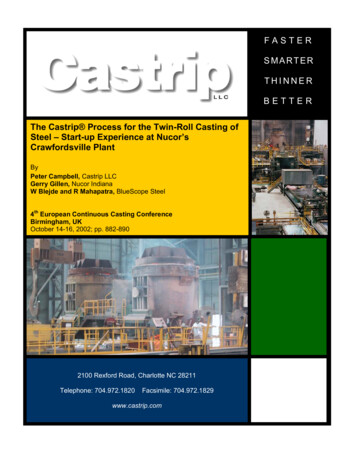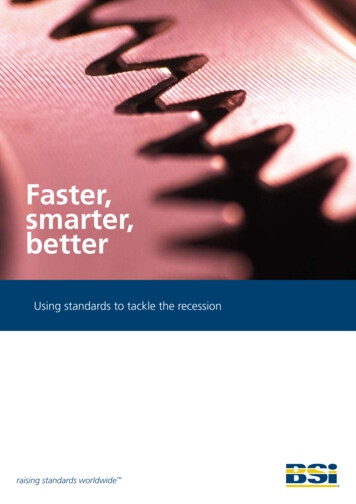
Transcription
FASTERSMARTERTHINNERBETTERThe Castrip Process for the Twin-Roll Casting ofSteel – Start-up Experience at Nucor’sCrawfordsville PlantByPeter Campbell, Castrip LLCGerry Gillen, Nucor IndianaW Blejde and R Mahapatra, BlueScope Steel4th European Continuous Casting ConferenceBirmingham, UKOctober 14-16, 2002; pp. 882-8902100 Rexford Road, Charlotte NC 28211Telephone: 704.972.1820Facsimile: 704.972.1829www.castrip.com
THE CASTRIP PROCESS FOR TWIN-ROLL CASTING OF STEEL –START-UP EXPERIENCE AT NUCOR’S CRAWFORDSVILLE PLANTPeter Campbell*, Gerry Gillen , Wal Blejde# and Rama Mahapatra#With hot commissioning started in early May 2002, Nucor Crawfordsville has become thefirst fully commercial strip casting facility in the world. Employing the CASTRIP twin-rollcasting technology, Nucor aims to cast steel strip at 1.0 to 2.0 mm in thickness with a widthof between 1000 and 2000 mm. At casting speeds approaching 100 m/min, the Nucor casteris capable of producing 500,000 tons per year. Over the past decade, BHP Steel and IHI havedeveloped the CASTRIP process through pilot plant and full-scale development facilities inAustralia; Nucor joined the effort in 2000. The following paper includes a discussion of thekey process metallurgy breakthrough areas associated with the technology and a briefbackground on its development. A description of the Crawfordsville CASTRIP facility is alsoprovided.INTRODUCTIONNear-net-shape casting of metal products has long been of interest to metallurgists and themetals industry. Obvious savings in equipment plus efficiencies related to hot and coldworking as well as reheating have been the main driving force. For more than a decade, BHPSteel and IHI (Ishikawajima-Harima Heavy Industries) collaborated on twin-roll castingdesign at development facilities in Wollongong, Australia. The codename for this venturewas Project ‘M’ and the project covered laboratory, pilot plant and full-scale developmentfacilities. In 2000, Nucor Corporation joined forces with the team, forming Castrip LLC, ajoint venture company aimed at commercializing the new technology. Construction is nowcomplete at Crawfordsville, Indiana, also home to the world’s first thin slab caster. Hotcommissioning and casting trials began in early May and the Nucor plant is expected to rampup commercial production over the next 6 to 12 months.For the past decade or so, strip casting of steels has been an interesting technical curiosity forthe steelmaking community. Many projects and collaborative efforts have been initiated,practically worldwide; however none has been run at a full commercial level for extendedperiods. With the construction of the Nucor CASTRIP facility at Crawfordsville, the directcasting of sheet products will become a commercial reality. The following paper describessome of the key process fundamentals of CASTRIP technology and provides details on thefirst installation at Crawfordsville. Physical properties for typical CASTRIP products are alsoincluded.*Castrip LLC, Charlotte NC USANucor Steel Indiana, Crawfordsville IN USA#BHP Steel, Crawfordsville IN USA CASTRIP is a registered trademark of Castrip LLC
PROCESS OVERVIEWThe CASTRIP process is based upon the same concepts that Henry Bessemer patented in themid-19th century. Figure 1 shows a simple schematic of the basics of the process – twocounter-rotating rolls that provide a surface or mold against which molten steel solidifies. Asthe figure indicates, the steel begins to solidify against the rolls just below the meniscus andshell growth continues as they move as it moves downwards through the melt pool. At theroll nip or pinch-point, the two shells are essentially fused together forming a continuousstrip, which then exits the caster in a downward direction.Counter-rotating RollsLiquid MetalSolid StripFig. 1 – Simple schematic of twin-roll strip casting process.Although the concept is extremely simple, its application at a commercially viable productionlevel has proven to be extremely difficult. Several technical advancements have occurred inrecent years that have made twin roll casting possible at a commercial level. These include: High speed computing and process controlAdvanced ceramics and materials (including copper alloys)Sensing technologyMathematical modeling of physical phenomenaIn addition to these advancements, the Project ‘M’ team had to significantly increase thebody of knowledge related to several key areas of process metallurgy directly connected tothe twin-roll process. Previous papers have discussed the development of the CASTRIPprocess (1-4); these advancements or breakthroughs are what sets CASTRIP technology apartfrom other twin roll processes and can be divided into 5 key areas:1.2.3.4.5.Metal deliveryEarly solidificationEdge containmentRoll distortionRefractories
Metal delivery - Metal delivery to the melt pool is critical for a number of reasons. Unlikeconventional casting, the melt pool is very small in the CASTRIP process. This is particularlyso due to the 500-mm diameter casting rolls, which are significantly smaller than rollsutilized in other twin roll casting projects (5). As a result, the ratio of mass flow rate into thepool divided by the pool volume is nearly an order of magnitude higher in the CASTRIPprocess compared to slab casting. Thus, the metal delivery nozzle or core nozzle utilized inthe CASTRIP process is completely different than that used for conventional casting, withmajor emphasis on reducing the turbulence in the steel as it enters the melt pool plus theandthe need for effective distribution of metal along the roll length. A further requirement of themetal delivery system is to provide metal to the meniscus in a stable and repeatable manner.Any disturbance at the meniscus invariably manifests itself as a strip defect; thus the processmust be stable and in control at all times to ensure excellent surface quality.SENNozzleSlag RimFluxMouldMeniscusCasting Roll(a)MeniscusMelt(b)Fig. 2 – Comparison of the meniscus region in (a) the CASTRIP process and (b) conventionalslab casting.Early solidification - Most of the effort related to the understanding of solidification in steelshas been confined to continuous casting over the past 20 years. There are some majordifferences between CASTRIP technology and slab casting that have significant effects onthe formation and growth of the shell. Figure 2 shows a close-up of the meniscus area in bothprocesses. Among the main differences between the two processes are, that the CASTRIPtechnology does not use any type of mold powder or lubrication and that the mold (roll) andsteel shell remain in direct contactmaintain the same velocity, i.e. no mold oscillation. As aresultBecause there is no mold powder, there is significantly better contact between the rollsurface and solidifying shell, starting at the meniscus and extending down to exit at the rollnip. Significant work has been done in trying to understand the mechanisms for shell
formation and growth as well as heat transfer between the steel and roll surface. This workhas been described previously by Mukunthan et al. (1) and it is critical that the variablesaffecting the early solidification of the shell and its subsequent growth be understood for theproduction of quality strip. Recently, independent research work at Carnegie MellonUniversity has provided further detail related to interfacial phenomena and the solidificationof carbon steels during strip casting (6).One of the many problems that can arise from poor control of solidification and uneven shellgrowth is depicted in Figure 3. As indicated in the X-ray map taken of a strip with poorsolidification control (Figure 3 (a)), the formation of porosity is a result. This is because theuneven solidification of the shell creates an uneven solidification front, which can trap liquidsteel below the roll nip. Bringing nucleation and early solidification under control results in asmooth solidification front, thereby preventing porosity (Figure 3 (b)).(a)(b)Fig. 3 – X-ray maps indicating the level of porosity in the solidified steel strip, (a) early castsshowing porosity and (b) later casts with no porosity.Edge containment – Although most of the surface area of the solidifying strip is confined tocontact against the face of the rolls, the edge containment of the melt pool proved to be atechnical challenge that required significant focus during the development of the CASTRIPprocess. The problem is related to the fact that freezing is most likely to occur in this areabecause of heat loss through the side dam material as well as through the rolls. Prematurefreezing can lead to poor edge quality as well as triggering a series of events that eventuallylead to the cessation of casting. Many materials have been tested for use as side dams beforea suitable refractory was found. Also, it was found that the design of the metal deliverysystem could greatly affect the performance of the side dam through the proper supply ofliquid metal towards the edges of the melt pool. Figure 4 shows a typical untrimmed sidewallof a coil cast at Project ‘M’.
Fig. 4 – Photograph of typical coil sidewall produced with the Castrip process at Project ‘M’.Roll distortion – Roll distortion is caused by the generation of thermal stresses as the castingrolls become heated by the solidifying steel. The proper design of casting rolls must take intoaccount this unavoidable distortion in order to produce strip with a desired thickness profile.Previous publications have demonstrated the variation in heat flux and temperature across acasting roll (2). This work also showed that rolls with a machined in crown where the centeris smaller in diameter than the edges will provide the optimum strip profile.Refractories – The interaction between the liquid steel in the melt pool and the refractoriesutilized for the metal delivery nozzle hasve been shown to cause defects in the strip castmaterial (2). Active oxygen contained in the pool was shown to combine with carbon in thealumina graphite nozzle, resulting in the formation of CO bubbles. These bubbles causeddisturbances at the steel surface and at the meniscus, where they inevitably resulted in surfacedefects in the strip. Defects caused by this mechanism have been eliminated through theselection of appropriate refractory materials.Table I – Typical CASTRIP UCS product attributes as compared to conventional material.Typical CASTRIP ProductsAs-Cast Product In-Line Hot RolledAttributeUnitsYield StrengthTensile StrengthElongationSurfaceRoughnessSurface ScaleCenterlineGauge VariationTypical CrownMPaMPa%µm300440261.5 – 2.032045028 0.5Conventional HotRolled Product250 - 300380 - 45025 - 351 – 1.5µmmm 2 0.054 2 0.0344-7*mm0.050.050.025 – 0.075* - ASTM Specification A568M Standard Thickness Tolerance for Hot-Rolled Sheet - 0.15 mmThe previous paragraphs describe the process metallurgy breakthroughs related to CASTRIPtechnology. Through this understanding plus process design, automation and control, theCASTRIP process has demonstrated the ability to make commercially acceptable product for
a variety of applications. Details on the product attributes such as surface quality,dimensional control, mechanical properties and microstructure have been publishedpreviously (4), and some of them are summarized in Table I. The development work inAustralia plus subsequent product evaluation by Nucor has shown that CASTRIP UCS(Ultra-thin Cast Strip) can be substituted for conventional hot and cold rolled steel sheet.NUCOR’S CASTRIP PLANTConstruction of the Crawfordsville CASTRIP facility began in February 2001. Fed from theexisting EAF shop located less than 0.5 miles away, the CASTRIP caster building includes aladle metallurgy furnace (LMF) to make the necessary temperature and chemistryadjustments prior to casting. Figure 5 shows a sketch of the general building layout indicatinga dimensions of approximately 135 meters in width and 155 meters in length. The total lengthof the casting operation, from ladle turret to coilers is only 60 meters. This is in contrast to aslab caster with reheat furnace and hot strip mill that typically requires 500 to 800 meters oflength to make the same hot rolled products.135 mLadle from EAFLMFTURRETROLLPREPPULPITCASTERROLLINGMILLTUNDISH &REFRACTORYPREP155 EARCOILSTORAGEFig. 5 – General layout of the Crawfordsville CASTRIP building.A profile schematic of the Castrip facility is shown in Figure 6, indicating the main featuresof the process. The ladle and tundish are based on standard steel industry designs, as is theladle turret (not shown). The tundish feeds a transition piece, which is situated just above thedelivery (core) nozzle. The caster does not use a dummy bar for start-up. Upon exit from thecasting rolls, the solidified strip is directed to a pinch roll and then through a hot rollingstand. In this transition, the atmosphere is controlled to limit oxide formation on the strip.Equipment from the hot rolling mill through the coilers is of standard steel industry design.
LadleTundishTransition Piece & Delivery NozzleHot Rolling StandCooling TableShearCasting RollsControlled AtmospherePinchRollsPinch RollsCoilersFig. 6 – CASTRIP process schematic.General specifications for the Crawfordsville CASTRIP facility are shown in Table II. Ofparticular note is the diameter of the casting rolls – 500 mm. This diameter is significantlysmaller than other twin-roll casting projects and one of the main advantages of the CASTRIPprocess. Smaller rolls are less expensive to build, have a lower operating cost and are capableof producing thin, high quality cast products. The CASTRIP process has the capability ofcasting steel strip at 1.0 to 2.0 mm in thickness, plus a single hot rolling stand to reduce thematerial another 40%. At casting speeds of 80 m/min and strip widths of 1345 mm andgreater, the output of the plant is expected to be 500,000 tonnes per year.Table II – Crawfordsville CASTRIP Plant SpecificationsUnitSpecification (in metric units)Building Dimensions155 m x 135 mHeat/Ladle Size110 tonnesCaster Type500-mm Diameter Twin RollCasting speed80 m/min (typical)150 m/min (maximum)Product Thickness0.7 to 2.0 mmProduct Width2000 mm maximumCoil Size25 tonnes
In-Line MillSingle stand – 4 High with HydraulicAGCWork Roll Dimensions475 x 2050 mmBack-up Roll Dimensions1550 x 2050 mmRolling Force30 MN maximumMain Drive3500 kWCooling Table10 top and bottom headersCoiler Size2 x 40 tonne coilersCoiler Mandrel760 mm diameterAnnual Capacity 500,000 tonnes/yearA photograph taken during commissioning of the CASTRIP plant at Crawfordsville is shownin Figure 7. The photo shows the strip emerging from the rolling mill with the caster deckand ladle in the upper background. The twin casting rolls are located below the ladle andbehind the rolling stand.Fig. 7 – Photograph of Nucor’s CASTRIP plant during commissioning. Note steel stripemerging from the single hot rolling stand.CONCLUSIONSThe commercial-scale production of steel sheet products via the twin-roll casting process isimminent with the recent commissioning of Nucor’s Crawfordsville CASTRIP facility. The
production of flat rolled products utilizing the CASTRIP process has many advantages overconventional casting and rolling technology, including lower capital and operating costs,reduced energy usage and emissions, thinner higher value products and a smaller, moreflexible operating dimensionsregime. Further, due to its lighter gauges ( 1.5 mm) andexcellent surface quality, CASTRIP products can be substituted for cold rolled sheet in manyapplications and will likely create a new product category for flat rolled sheet productsknown as UCS.REFERENCES1. K. Mukunthan, L. Strezov, R. Mahapatra and W. Blejde, “Evolution of microstructuresand product opportunities in low carbon steel strip casting”, The Brimacombe MemorialSymposium Proceedings, 2000, 421-437.2. W. Blejde, R. Mahapatra and H. Fukase, “Application of Fundamental Research atProject ‘M’”, The Belton Memorial Symposium Proceedings, 2000, 253-261.3. W. Blejde, R. Mahapatra and H. Fukase, “Recent Developments in Project M – The JointDevelopment of Low Carbon Steel Strip Casting by BHP and IHI”, InternationalConference on New Development on Metallurgical Process Technology, METECCongress, June 1999, 176-181.4. W. Blejde, R. Mahapatra and H. Fukase, “Development of Low Carbon Thin StripProduction at Project M”, Iron and Steelmaker, Vol. 27, No. 4, 2000, 29-33.5. J. Herbertson, “The Emergence of Strip Casting – Challenges and Impacts of Success”,Dr. Manfred Wolf Symposium Proceedings, 2002, 60-69.6. N. Phinichka, P. Misra, Y. Fang and A.W. Cramb, “Initial Solidification Phenomena inthe Casting of Steels”, Dr. Manfred Wolf Symposium Proceedings, 2002, 46-59.
FASTER SMARTER THINNER BETTER Telephone: 704.972.1820 Facsimile: 704.972.1829 www.castrip.com The Castrip Process for the Twin-Roll Casting of Steel – Start-up Experience at Nucor’s Crawfordsville Plant By Peter Campbell, Castrip LLC Gerry Gillen










